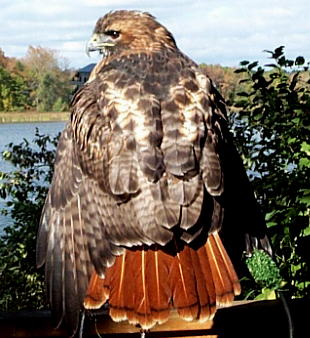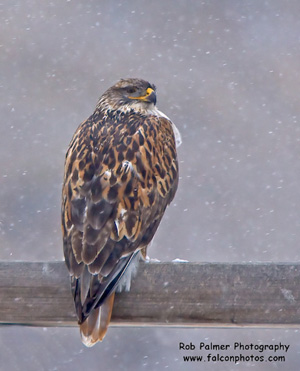Red-tailed Hawk (Buteo jamaicensis)

Description
- White breast, dark brown back, with a rust colored tail
- Immatures are more streaked and lack the rust colored tails
- 14 sub-species, each of which is more or less specific to a geographical area, and differs from the others in size, markings etc.
Size
- Length: 18-25" (46-63 cm)
- Wingspan: 48" (1.2 m)
Range
- Plains, farmland, deserts, and open woodland
- Throughout North America to the northern limit of the tree line in Alaska and Canada, and south as far as the mountains of Panama
Diet
- Mostly small and medium sized rodents
- But very opportunistic and can be found feeding on whatever is the most abundant and easiest prey to attain.
Voice
- High pitched descending scream- "Kee-yrrr Kee-yrrr"
- Young also beg for food with a - "klee-uk klee-uk klee-uk"
Nesting
- Stick nest line with bark and green vegetation
- 15-70 ft. above ground level
- Lay 2-3 brown spotted eggs
- Eggs incubate for 28-32 days
- Fledgelings leave the nest at 45 days after hatching
Ferruginous Hawk (Buteo regalis)

Description
- Brown above with rusty streaks, white below with rusty streaks
Size
- Length: 20-26 in. (50-66 cm)
- Wingspan: 53-60 in. (134-152 cm)
- Weight: 2.2-4.5 lbs (980-2030 g)
Range
- North American plains
- Plains and dry mesas
- Great Basin East to Western Great Plains, north to Canadian Praries, south to Arizona and New Mexico
- In winter it moves further south into the south western United States and northern Mexico
- Those further north tend to move south during the first half of October, returning in late March or early April
- When migrating the birds rarely flock, but remain in pairs or small groups
Diet
- Rabbits, hares and other small mamals
- Locusts or Jerusalem crickets when swarming
- Occasionally small snakes
Voice
- Main call is described as a loud "kree-a"
- Also makes a harsh cry rather like one of the notes of a herring gull's call
Nesting
- Mass of sticks, twigs, bones lined with cow or horse feces in a tree or on a cliff
- Uses the highest available, but frequently almost at ground level
- Same nest is used, and added to, year on year and can grow to the size of a Golden Eagle's nest, 12 to 15 feet (360 to 460 cms) in height
- Lay 2-6 white or bluish eggs heavily spotted brown
- Eggs incubate for 28 days and are tended by both parents
- Fledgelings leave the nest at 44-48 days after hatching
|